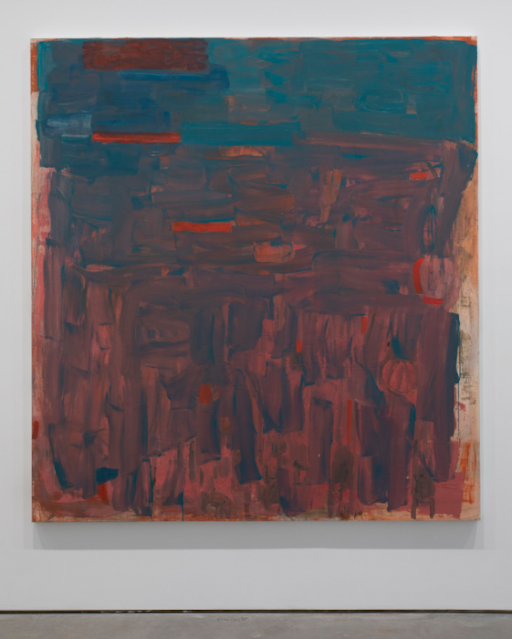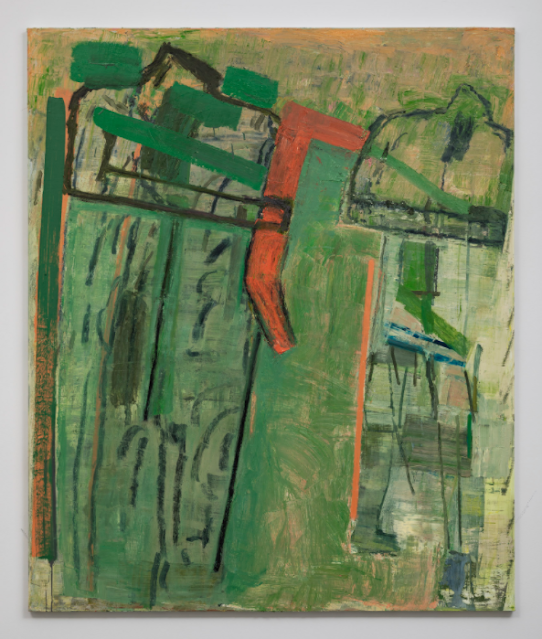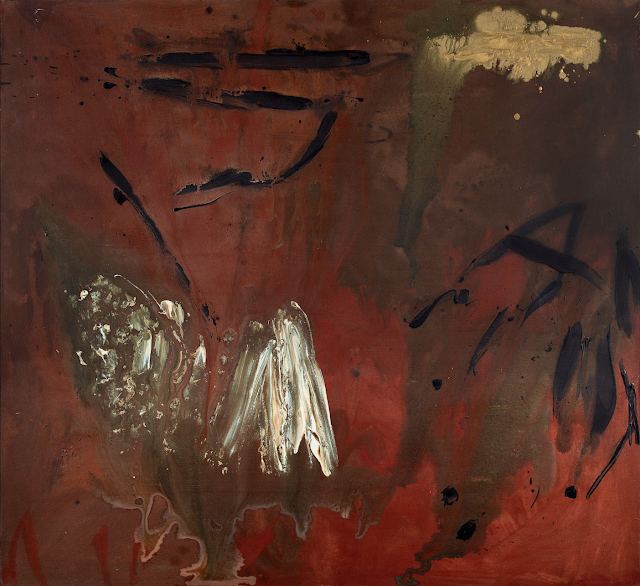Thursday, October 22, 2020
New in the Studio
Wednesday, October 21, 2020
Amy Sillman: Twice Removed At Gladstone Gallery
The time we’re living in is crazy, horrible, almost medieval with disease, increasing police brutality and militarization, diminishment of democratic rights, and the upcoming ledge of a terrifying election. I was supposed to have a show of drawings and paintings last May at Gladstone and titled it “Twice Removed”: "twice" to propose the idea of a multiplied subjectivity, being of two minds, forked paths, and having allegiances to both subject and object, thinking and feeling, abstraction and figuration, form and content, dialectics and contradictions; "removed" because my paintings are built through negation, a kind of violent erasure, scraping down, undoing, getting rid of. But twice removed was also a pun on the family relation, being adjacent to something older. I’m a knight’s move away from the old tradition of gestural painting, but I’m really not trying to kill the father: I love gestural painting like it was my grandma, even though I’m skeptical, pessimistic, and sometimes critical of what she stands for. (My mom always said I was too negative.) So I was also thinking about painting as an unrolling of time—both my own genealogy and the way I wanted to unfurl paintings and drawings in long horizontal sequences around the room. I wanted the work to be like scraps and fragments, a bunch of spare parts, puzzling things dug up archeologically, arranged around the rooms of the gallery in a frieze of tangled patches. I was already thinking bleak thoughts about America, and the work looked like it: melancholy, mostly only black and white, ambiguous, often either too raw or over-cooked, ambiguous. I was trying to make a new language out of a bunch of spare parts.
That show was postponed due to Covid19 and will now open in late September. But the new show is an even more shaggy, complicated affair, containing all of the above plus all the new work from this agonizing spring and summer shuffled in. For much of this time, I didn’t have a painting studio, so I just drew flowers, the opulent irises, daylilies, and sunflowers that were springing up around me from bushes and trees and from the earth. As Lorraine Hansberry asked (in her 1962 play), “what use are flowers?” I was obsessed with their colors and shapes, the simple joy of observing them, and how they exude libido, healing, and rebirth, even though while I was drawing them I was wondering if we might all die. Were they funerary or optimistic? During this spring, painting itself was overshadowed by the question of whether painting-life could continue to exist at all. But after months of the flowers, they started to morph into abstractions. The flower stems looked like the legs of figures stalking around, their heads bent over in a kind of looped narrative with no particular story except growth and then withering. The world’s ground was shifting, so I started concentrating on the fields behind the figures— patterns, plaids, and confusing figure-to-grounds, a purposefully destabilized signal-to-noise ratio. And eventually, it was the process of improvisation itself that seemed the most timely and urgent. I was thinking about a quote by Fred Moten, “improvisation is making nothing out of something.” In this sense “nothing” is a good thing, it means you’re in a hole, on the brink of change, and you have to listen, to pay attention. Improvising is a process that comes from within and that proposes a without, a nowhere that is everywhere. The hard questions continue (how to keep making paintings at all, if the world can possibly be rebuilt, and how) but I hope there's an alchemy in there, a use, in keeping on working with the motion between the known and an abstract (but felt) unknown.
Sunday, October 18, 2020
Patrick Graham: Interitus at Hillsboro Fine Art
Friday, October 16, 2020
Jullian Schnabel at PACE
Wednesday, October 14, 2020
Jeffrey Morabito: Open Studio
Fri, Sat and Sun, Oct. 16th - 18th, 2020
David Pollack: New on Paper Since COVID-19 at Monklike Habits | online project space
From the Press Release:
But the paintings also support an underlying humanity - a joining with (in death?), or perhaps a transcendence from, an irrational, subjective megacosm. This ingredient, more than anything, confirms the poetic sensitivity in the work."
Blurring Boundaries: The Women of American Abstract Artists, 1936 - Present at South Bend Museum of Art
(info)
The Robert C. Shields American Series is an annual event that shares, with our regional audience, the rich art history and culture of our nation. Represented in these exhibitions are many of the key artists and artistic movements responsible for creating an American art legacy. This will be the 13th year we have offered this series and it continues to gain momentum and respect in the community for the rich visual perspectives it offers on American art.
An awe-inspiring celebration of an intergenerational group of artists—one that is both comprehensive and long overdue—Blurring Boundaries: The Women of American Abstract Artists, 1936 – Present highlights the indelible ways in which the women of American Abstract Artists have, for more than eighty years, shifted and shaped the frontiers of American abstraction.
The hierarchy of distilled form, immaculate line, and pure color came close to being the mantra of 1930s modern art—particularly that of American Abstract Artists (AAA), the subject of a new exhibition entitled Blurring Boundaries: The Women of American Abstract Artists, 1936 – Present. From the outset—due as much to their divergent status as abstract artists as to their gender—women of American Abstract Artists were already working on the periphery of the art world. In contrast to the other abstract artist collectives of the period, where equal footing for women was unusual, AAA provided a place of refuge for female artists. Through fifty-four works, Blurring Boundaries explores the artists’ astounding range of styles, including their individual approaches to the guiding principles of abstraction: color, space, light, material, and process.
More than eighty years after its founding, AAA continues to nurture and support a vibrant community of artists with diverse identities and wide-ranging approaches to abstraction. In celebration of this tradition, Blurring Boundaries: The Women of American Abstract Artists traces the extraordinary contributions of the female artists within AAA, from the founders to today’s practicing members. Included are works by historic members Perle Fine, Esphyr Slobodkina, Irene Rice Pereira, Alice Trumbull Mason, and Gertrude Greene, as well as current members such as Ce Roser, Irene Rousseau, Judith Murray, Alice Adams, Merrill Wagner, and Katinka Mann.
Blurring Boundaries: The Women of American Abstract Artists, 1936-Present was organized by The Clara M. Eagle Gallery, Murray State University, Murray, KY, and the Ewing Gallery, The University of Tennessee, Knoxville, TN and is toured by International Arts & Artists, Washington, DC.
Tuesday, October 13, 2020
Ann Purcell: Kali Poem Series at Berry Campbell
Kali Poem #52 (Vanishing Time ||), 1987-89
Ann Purcell: Kali Poem Series
October 15 - November 14, 2020
view exhibition | view catalog
For pricing information email: info@berrycampbell.com
Berry Campbell
530 W 24th Street
New York, NY 10011
Tuesday - Saturday, 10 am - 6 pm
COVID-19 precautions will be observed.
Kali Poem #46 and #47 (Vanishing Time), 1989
Blue Deep (Kali Poem #41), 1987
[ii] Jane Livingston, Five Washington Artists, exh. cat. (Washington, D.C.: Corcoran Gallery of Art, 1976).
[iii] Barbara Gold, “Five Plus One at Corcoran,” The Sun (Baltimore), September 26, 1976, p. D8.
[iv] Margaret Seaver, “Ann Purcell, A Self-Assured Artist,” The Summer Advocate (Provincetown, Massachusetts), August 16, 1984.
[v] Benjamin Forgey, “Washington, D.C.: Catching Up with Morris Louis,” Art News (November 1976), p. 104.
[vi] Dan Cameron, “Ann Purcell,” Arts (November 1983).
[vii] Pamela Kessler, “Four Artists in Search of No Subject,” Washington Post, September 25, 1987, p. WK47.
In Common Writers Series: John Yau and Andrew Joron, Reading and in Conversation
John Yau | Andrew Joron
For the last program in The Poetry Center's In Common Writers Series for 2020, we are delighted to host renowned poet and art critic John Yau, appearing from New York City for two dates. He's joined Thursday, October 15 by poet, translator, and SF State faculty member Andrew Joron, each of them reading their poetry and talking with one another and in response to questions from the audience. Then, on Saturday evening October 17, Yau is reading and in conversation, focusing on his work as art critic and curator, with poet/performer and editor of Open Space at SFMOMA, Claudia La Rocco, with emcee Brandon Brown. Thursday night's emcee is Carlos Quinteros III.
This remote-access event starts promptly at 7:00 pm Pacific Time and is free and open to the public. Real-Time Captioning provided here. For other reasonable accommodations please contact poetry@sfsu.edu.
- Inauguration Day
If you think the next President
is going to improve your quality of life
you choose to believe
that war is a three-letter word
that does not affect anyone it touches
except the tender pages of youth
You know, those dirty sheets
young lovers write odes on
before they die between blinks
—John Yau, from Bijoux in the Dark
John Yau is a poet, fiction writer, critic, editor, curator, and publisher of Black Square Editions, a small independent press that has published books and broadsides of poetry, fiction, criticism, and translation, as well as prints. He has contributed to essays in many catalogs and museum publications, as well as written for Art in America, Artforum, Art News, New York Times, Los Angeles Times, and Art Press. His work is included in many anthologies of poetry, fiction, and criticism, and has been translated into French, German, Italian, Portuguese, Spanish, and Chinese. After serving as the Arts Editor for the Brooklyn Rail (2007–2011), Yau left and helped start the online journal Hyperallergic, where he frequently posts his reviews.
Yau is the author of over 40 books, recently Bijoux in the Dark (poetry, Letter Machine Editions, 2018), The Wild Children of William Blake (essays, Autonomedia, 2017), Foreign Sounds or Sounds Foreign (essays, Madhat Press, 2020), and artist monographs on works by Philip Taafe (Lund Humphries, 2018) and Suzan Frecon (David Zwirner Books, 2020). He has received fellowships from the John Simon Guggenheim Memorial Foundation, National Endowment for the Arts, Academy of American Poets, New York Foundation of the Arts, Ingram Merrill Foundation, and the General Electric Foundation. Yau was named a Chevalier in the Order of Arts and Letters by the French government in 2002. He is a Professor of Critical Studies at Mason Gross School of the Arts (Rutgers University) and lives in New York. More at poets.org
Andrew Joron is the author of The Absolute Letter, a collection of poems published by Flood Editions (2017). Joron’s previous poetry collections include Trance Archive: New and Selected Poems (City Lights, 2010), The Removes (Hard Press, 1999), Fathom (Black Square Editions, 2003), and The Sound Mirror (Flood Editions, 2008). The Cry at Zero, a selection of his prose poems and critical essays, was published by Counterpath Press in 2007. From the German, he has translated the Literary Essays of Marxist-Utopian philosopher Ernst Bloch (Stanford University Press, 1998) and The Perpetual Motion Machine by the proto-Dada fantasist Paul Scheerbart (Wakefield Press, 2011). As a musician, Joron plays the theremin in various experimental and free-jazz ensembles. Joron teaches creative writing at San Francisco State University.

























